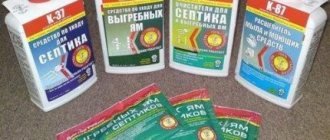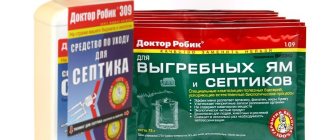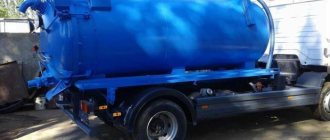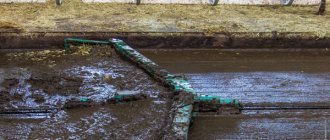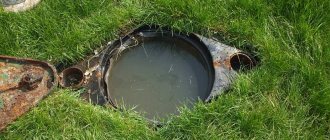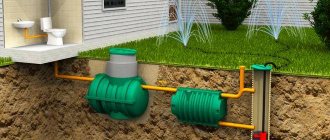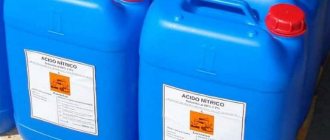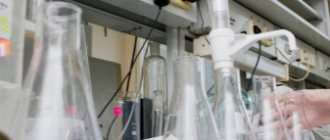Top 7 best bacteria for septic tanks and cesspools
Bacteria for septic tanks are used by residents of private houses that do not have the ability to connect to the main sewer line. To clean wastewater on the property, they organize the construction of a septic tank or cesspool.
When bacteria enter sewage, they help break down organic matter, eliminate odors from sewers, and speed up the process of processing sewage. To find out which bacteria are best for a septic tank, you should study the pros and cons of the products and study their purpose.
Attention! Beneficial bacteria transform sewage into a mass that is safe for the environment and people. Bacteria multiply quickly in the mass of waste; this is an excellent environment for them to live and multiply.
How to choose bacteria for septic tanks
Cesspool bacteria are cultures grown in a nutrient medium that feed on organic matter. Depending on the form of the drug, they are dried (powders and tablets) or made into an aqueous solution. In the preparation, the bacteria are in a dormant state; certain actions are required to activate them. They depend on the form of release and are written in detail on the packaging. Accurate execution of instructions is very important to obtain results.
Regardless of the form of release, most drugs can be used to enhance processing in septic tanks. Dosages change (septic tanks usually have a larger volume than a pit) and the method of “delivery” to the destination. In the case of home drains, bacteria can also unclog the drain. To do this, the drug is poured into the sewer and not used for at least 24 hours. During this time, microorganisms dissolve fats and stuck waste and the water begins to drain better. This is a good replacement for chemicals, especially for septic tanks or for VOCs, because after cleaning with chemicals, the quality of processing noticeably decreases. Otherwise, you will simply add another portion of bacteria, which will only make the wastewater cleaner.
Bacteria for cesspools are released in three types of preparations:
- dosed powders;
- liquid solutions;
- in the form of tablets.
Large selection of products
In principle, the form of release does not matter. The number of microorganisms, their condition and degree of “freshness” are important. All drugs have a limited shelf life. Be sure to check the dates when purchasing. The later the date, the worse - the bacteria could die.
Manufacturers also standardize storage conditions. Usually this is temperature - the drug should not freeze (in theory, it should not even cool below +10°C). It is impossible to know whether the storage conditions were observed. You can only believe it empirically - if the drug does not work, the reason may be that the bacteria died as a result of improper storage.
What to do with bacteria in powder form
Powdered septic tank products occupy the majority of the market. It's convenient: they are packaged in small bags. You usually need to pour out one sachet at a time; more is required only for the initial (first) load. There may be powder inside, or there may be granules - it varies from manufacturer to manufacturer.
Method of using bacteria for cesspools in powder form
As a rule, the powder must be diluted in water, left for a while, and then poured into the cesspool.
Liquid solution for cesspools
This is a concentrated solution of bacteria. Just like dry preparations, concentrates must be “fresh” and stored at above-zero temperatures. Overheating is also not allowed - the upper limit of viability of most bacteria is 40-45°C.
Liquid products usually just pour out
Using sump fluid is even easier. All you need to do is measure the required volume (set in milliliters or caps) and pour it into the hole. Sometimes it is necessary to dilute the drug in water and then pour it away. Everything is clearly stated in the instructions.
Toilet tablets
This type of septic tank bacteria is formed into small discs, shaped like tablets, only with a much larger diameter. There is a certain amount of them in a bag or tube. Each tablet is packaged in plastic film. Before adding the cesspool, the shell is removed and the product is thrown inside.
Tablets for country toilets are simply thrown inside
If the home sewer system is made from a septic tank, throw the tablet into the toilet, wait until it dissolves, and then flush the water.
How the bacterial method works
Bacteria for purification are grown in laboratory conditions; they are in an inactive form in the form of an enzyme concentrate. Their effectiveness can be observed in liquid media. To survive, microorganisms must eat something. Once in the toilet, they begin to eat waste : leftover food, feces, plant waste, wood products. Thus, the process of breaking down solids is accelerated. As a result, water and a small amount of mineral sediments remain, which are used as fertilizers.
You should not introduce bacteria into a clean septic tank or a new cesspool.
First you need to add several buckets of water there. After the bacteria “populate”, the effect will be noticeable after 1.5-2 hours (the volume of sewage and the smell will decrease).
What effect should you expect?
If you believe the advertising of some preparations for processing waste in sewage pits, barely half the volume of wastewater will remain in it, there will be no smell at all, and the liquid can be used to water the lawn. Reality differs significantly from promises. What you can really get:
- Significant reduction in fecal odor one to two weeks after the first load. If the treatment is carried out regularly, the smell really disappears.
- The volume of wastewater may decrease, but not dramatically. Everything that was in the hole remains in it. The level is reduced due to the fact that the solid components of the waste are processed - they turn into liquid, and the air contained in them is released. The processed substance is homogeneous and its odor is weak and usually not characteristic (sometimes fragrances are added)
- There will be fewer flies and midges. This is true - bacteria are processed and so are their larvae.
- If bacteria operate normally, the substrate obtained after processing is not toxic or hazardous to the environment. On the contrary, after “ripening” it makes an excellent fertilizer. The resulting slurry can be pumped out with a fecal pump onto a compost heap and used for its intended purpose after two to three years.
Cesspool bacteria can provide these results. They are not able to completely process wastewater to the state of pure or almost pure water.
Tips for use
If you are using the drug for the first time , then choose it marked “start” . In such products, elements have been added that have auxiliary effects on the life of the first colony of bacteria. The remaining liquid after the “work” of microorganisms in the pit must be removed using a pump . To prevent it from becoming clogged with solid residues, use a filter .
The water obtained as a result of purification cannot be used as drinking water; it can be used to water an area with vegetation.
If the bacteria have died , you must first find out the cause , eliminate it , and then add a new portion of microorganisms. In some cases, the bacteria may die. The following substances contribute to this:
- manganese;
- household chemicals;
- antibacterial drugs.
If the above elements get into a septic tank or pit, it is necessary to update and strengthen the colony of bacteria.
Why bacteria don't work
We have already mentioned several reasons - storage conditions were violated or the drug was “old”. In this case, there were simply no viable microorganisms or there were too few of them. But there are other reasons:
- You bought a fake. Popular, expensive imported drugs are especially often counterfeited. So it turns out that the same remedy works for some, but not for others.
- There is too little water in the hole. For normal life, bacteria in a country toilet need a sufficient amount of water. If your hole has no bottom, waste has been stored in it for many years, and the liquid goes into the ground. Even if the entire surface is covered with bacteria, they will not work. In order for them to process organic matter, the medium must be liquid.
- The temperature was too low or too high. Biological products for toilets are effective only at above-zero temperatures. The lower limit varies from product to product; it is usually +5-10°C. Also, bacteria do not like overheating - the upper limit of their “workability” is +40-45°C. Our air rarely warms up to such temperatures, but we must take into account that the decomposition of organic matter occurs with the release of heat, so the liquid can easily heat up to such degrees. The conclusion is simple: you need to add bacteria to cesspools in the spring, when there is a steel “plus” on the thermometer - so that there are no more night frosts. Bacteria need to create optimal conditions for life.
- The wastewater contains a large amount of active chemicals - bleach, detergents, etc. This environment is detrimental to bacteria; they simply die.
- A crust has formed in the pit. All bacteria that are found in preparations for sewage pits are anaerobic - they require oxygen to live. The crust does not allow oxygen to penetrate into the drains, which is why microorganisms die. If drains fall into a cesspool from a height, they break this crust. At least partially. If the level of waste is already such that the outlet of the waste pipe is below the crust, you will have to break it manually. The easiest way is to pour out a bucket of water, breaking this very crust. In industrial septic tanks there are aerators for this purpose, you can come up with something similar for yourself - throw a hose with holes made in it into the hole and from time to time connect a compressor to it.
- Preparations for country toilets work at a certain acidity. The environment can be neutral or acidic, but in an alkaline environment bacteria are practically inactive. If the cesspool is more than 3 years old and the waste has not been processed before this time, the environment in it is alkaline. In order for the bacteria in the cesspool to work, it is necessary to make the environment neutral or acidic. The easiest way is to pour out a bottle or two of vinegar. After a week, you can add bacteria. But this option only works for sealed pits (in which the liquid does not escape). This trick will not work with dry residue. You can only carry it out by hand.
As you can see, there are many conditions that affect the final result. To make it easier to deal with odors from the toilet and to ensure that waste decomposition is successful, it is better to start processing almost immediately after you start using the waste pit for its intended purpose. If it has already accumulated a large amount of waste, it is more difficult to recycle it.
Types of cleansing preparations
Today, septic tanks for cleaning cesspools are produced in two versions:
- Chemical;
- Biological.
Chemicals
- Chlorine and its compounds;
- Formaldehyde;
- Nitrogen compounds;
- Ammonium compounds.
Chemicals are used to disinfect and disinfect the contents of the cesspool. The drugs can be used at any air temperature. The action of the reagents is aimed at the total elimination of harmful microorganisms and infectious agents.
But it should be borne in mind that the reagents can partially penetrate into the soil and also cause corrosion of metal pipes. It is important to follow the exact dosage when using it to avoid unwanted effects. Remember that waste after using chemicals must be removed from the site: it is not suitable for fertilizing the soil.
Among chemical agents, the safest are nitrate oxidizers (nitrogen fertilizers). Activators included in nitrate oxidizers liquefy and disinfect feces and sewage, depriving them of their harmful properties. The resulting slurry can be used to water compost heaps.
Let's watch the video, a little about the septic tank and septic processes:
Ammonium compounds promote the decomposition of sewage and eliminate unpleasant odors. However, if soapy substances are present in the drains (after showering and washing), the ability of ammonium to decontaminate fecal matter is impaired. It is recommended to remove waste processed by ammonium from the summer cottage.
Remember that all chemical compounds are extremely harmful and have a high degree of health hazard. In this regard, some reagents are prohibited for use in household conditions (formaldehyde). Among the listed reagents, nitrogen is the safest.
Which bacteria are best for cesspools?
No one can say unequivocally “buy this drug and everything will work.” The same means work great for some, average for others, and barely work for others. Possible reasons were described above, but maybe it all depends on the type of waste that ends up in the pit. At the dacha there will be some chemicals, but most likely there will be a lot of organic matter and bacteria will be more active. There are more chemicals in household wastewater, and as a result, the same product may no longer be as effective, but another will work very well.
One of the effective drugs is Sanex
In general, what can be recommended is to try different drugs, starting with cheap ones. One of them will help you. By the way, there is one trick that will help intensify the processing processes. Periodically pour out-of-date kefir or sour milk into the waste pit; you can pour in a bag or two of semolina. Bacteria love protein, and there is little of it in waste. By feeding them you stimulate the development of the colony, the decomposition process will go faster.
There are a couple of comments about the “Dr. Robik” products for country toilets. These are products of an American company, but they have a factory in Russia. Russian-made drugs are called Roebik, American Roetech. The price difference is quite significant. Previously, the domestic Robik worked perfectly, so there was no point in overpaying, but in the last year the situation has worsened, so it’s worth thinking about.
Any of the drugs on the list has good reviews. It is impossible to say that all of them are positive, but most of them indicate good results. To ensure that bacteria for cesspools and country toilets do not disappoint, you need to buy them not at the market but in a store. There is a greater chance that storage rules will be followed. And in order not to buy a fake, it is advisable to buy from official representatives of the campaign. Information about this can be found on the website.
Consumer Reviews
“I purchased a septic tank with a tank volume of 3700 liters. Enough for our family of four. The tank is single chamber. There are no problems at work. I've been using this system for three years now. About cleaning the chambers from silting. It is enough to drain the sludge and wash the chamber once or twice a year, and everything works fine. If the lights are turned off, the system continues to work, although the speed decreases, but still, the process continues! I recommend." Nikolay, Nizhny Novgorod
“I bought a septic tank and have never regretted my choice. The wastewater settles and is cleaned of bacteria very well. There is practically no smell. I call the vacuum cleaner once a year. It's not expensive. My house is large, 8 people live in it. 4 cubic meters of capacity is enough so that our family is not bothered by the problem of drainage. The instructions say that there is a high-quality biological filter inside. This won me over. I am for environmental friendliness." Ivan, Ekaterinburg
“I don’t know what I did wrong, but all our bacteria died... I agreed with the seller, he came with a new set, measured something, changed it. We waited three weeks. I installed new ones and everything seemed to work. In general, it’s better to find an expert for money than to deal with these pills yourself. This whole idea cost me 2000 rubles for the work” Sergey, Samara
Principle of action of bioactivators
The smell is far from the only trouble with a country toilet. The mass that collects in the storage tank can be toxic in itself or become a source of spread of pathogenic microorganisms. This occurs due to the fact that putrefactive bacteria appear and actively multiply in the contents of the drive. Sometimes they are fought with the help of chemicals, but this method has its drawbacks:
- Firstly, due to the toxicity of the compounds, the risk of harmful substances entering groundwater and soil increases,
- Secondly, chemical antiseptics kill all microflora, and in the “uninhabited” territory, putrefactive bacteria will settle again as soon as the effect of the chemical that is deadly to them weakens.
The bioactivator for country toilets contains colonies of specially cultivated bacteria that displace pathogenic microflora. This method of struggle is not only more effective, but also gives a more durable result.
In turn, the “new settlers” that get into the storage tank from a bottle with a bioactivator contribute not to putrefactive processes, but to the decomposition and fermentation of organic matter. The difference between these processes from the user’s point of view is fundamental - waste is converted into non-toxic sludge or compost that does not have a sharp and unpleasant odor, gases and water that evaporate instantly. The comfort and safety of using the toilet is greatly improved, even if it is not equipped with a more advanced cleaning system.
Recommendations from septic tank manufacturers on the choice of washing powders and detergents
Septic tanks Topas, Unilos Astra and Eurolos work on almost the same principle. Manufacturers recommend their customers to use only biodegradable, natural-based products so as not to damage it.
Dishwashing detergents, laundry detergents, and drain cleaners should not contain chlorine, phosphates or other caustic chemicals. You should also avoid products containing synthetic surfactants. They can quickly kill the microbiota of a septic tank, but it will take several months to restore it.
What it is?
Antiseptics for cesspools are products that are used to prevent contamination in cesspools and remove odors. Any preparations in this series process sludge, which is certainly formed during the operation of the cesspool.
Important! Antiseptics also process liquid waste and large fractions - this makes it possible to pump out the contents as needed using a drainage pump.
Regular use of such preparations ensures that the cesspool will function effectively, and it will also be possible to avoid the appearance of an unpleasant odor. Which is a serious problem. Another property is the removal of pathogenic bacteria, which are certainly present in such a design. This allows you to protect the soil and prevent the occurrence of a dangerous situation for the environment in the event of an accident.
You can use an antiseptic for sewage in any system, both in a country house and a private permanent home. The key to ensuring that all the above functions will work is regular use.

